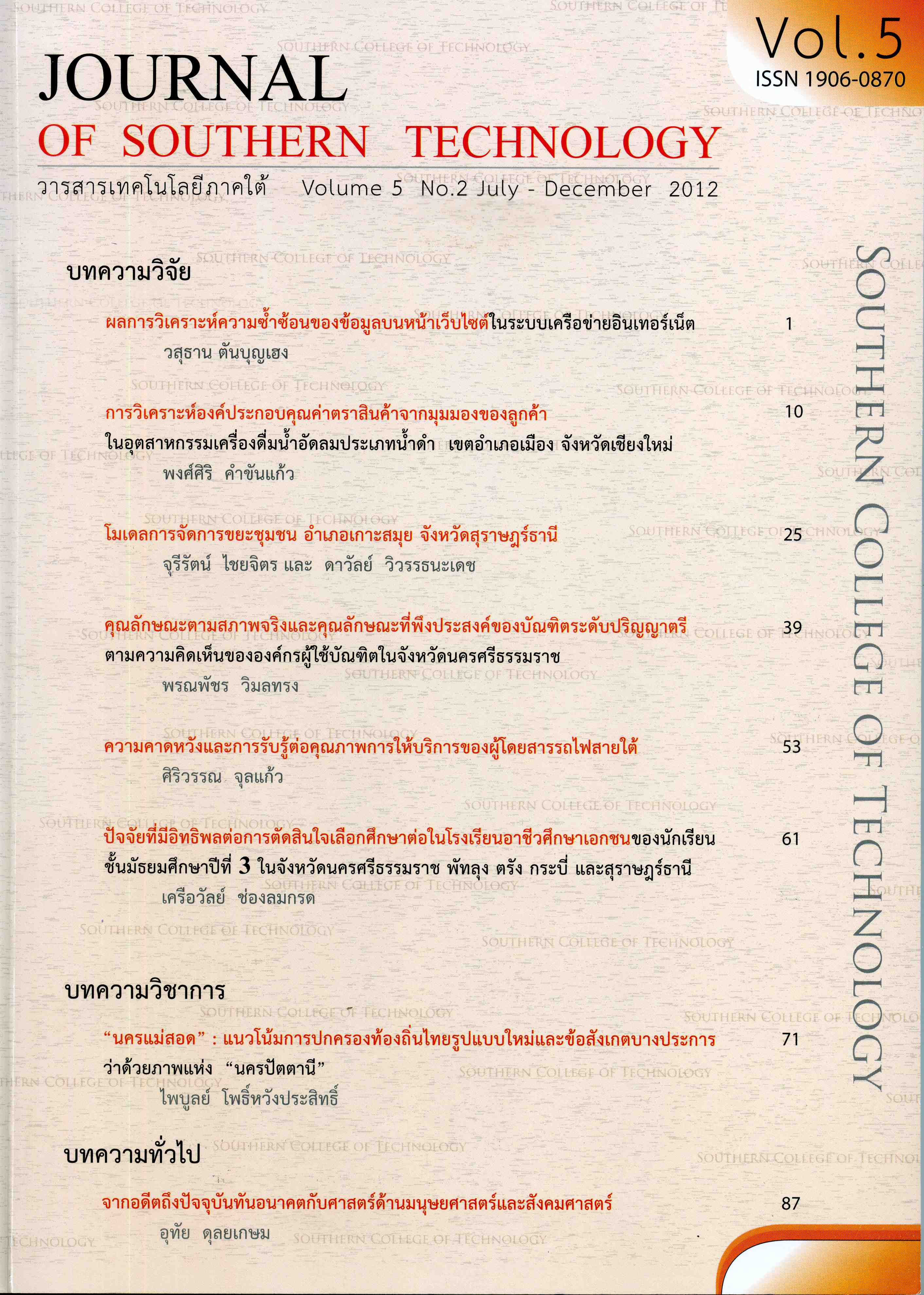The Factor Analysis of Customer-Based Brand Equity of the Black Carbonated Beverage Industry in Mueang District, Chiang Mai Province
Main Article Content
Abstract
The Objective of this research was to analyze the components of the customer-based brand equity of the black carbonated beverage industry in Mueang District, Chiang Mai Province. The sample group were consisted of 328 customers who have been drinking the black carbonated beverage. The research instrument was questionnaires, which tested for the reliability as 0.939 and the data analysis was done by using the factor analysis.
The results of the research found that the customer-based brand equity of the black carbonated beverage industry has four components and thirty – two variables as follows brand loyalty, brand perceived quality, brand association and brand awareness. The factor loading of these components was 0.508 – 0.808. In conclusion, this research was provided several key recommendations for Brand Manager’s the black carbonated beverage industry and market educator with valuable guideline for customer-based brand equity enhancing and competitive advantage of branding enhancing.
Article Details
-
Authors must agree to the journal publication rules and allow the editors to edit the manuscripts for publication.
-
Author’s right belongs to the author but Journal of Southern Technology holds the right of first publication and thus allow readers to use the article for the purpose of education but not commercial.
References
ธนาคารแห่งประเทศไทย, สำนักงานภาคเหนือ. (2553). รายงานแนวโน้มธุรกิจ ฉบับ เดือนมิถุนายน. ค้นเมื่อ 16 กรกฎาคม 2554. จาก http://www.bot.or.th/Thai/Economic .
ผู้จัดการรายสัปดาห์. (2549). กลยุทธ์บริหารยักษ์ใหญ่ เป๊ปซี่ ต้องขยันสร้างความจงรักภักดี. ค้นเมื่อ 16 กรกฎาคม 2554,จาก http://www.gotomanager.com/ news/details.aspx?id=49932.
Aaker, D.A. (1991). Managing Brand Equity: Capitalization the Value of a Brand Name. New York : Free Press.
Aaker, D.A. (1996). Building Strong Brand. New York : the Free Press.
Aaker, D.A., & Mills, M. K. (2005). Strategic Market Management. Australia : John Wiley and Sons.
Chen, C.F., & Tseng, W. S. (2010). Exploring Customer-based brand Airline brand equity: Evidence from Taiwan. Transportation Journal, Winter. 49(1) , 24-34.
Cochran, L.J. (1977). Sampling Techniques. New York: Wiley.
Davis, D. F., Golicic, S. L & Marquardt, A. (2009). Measuring brand equity for logistics services. The International Journal of Logistics Management. 20(2), 201-212.
Hatch, M.J., & Schultz, M. (2001). Are the strategic signs aligned for your corporate brand?, Harvard Business review, February, 1-8.
Hair, Joseph F. Jr., Black, William C., Babin, Barry J. & Anderson, R. E. (2010). Multivariate Data Analysis: A Global Perspective. Pearson Education, Inc., Upper Saddle River, New Jersey, USA: Seventh Edition.
Helander, M.G., & Khalid, H.M. (2000). Modeling the customer in electronic commerce. Applied Ergonomics, 31(6), 609-619.
Jacoby, J. (1971). A model of multi-brand Loyalty. Journal of Advertising Research, 11 (3), 25-31.
Keller, K. L. (1993). Conceptualizing, Measuring., & Managing Customer-Based Brand Equity. Journal of Marketing. January, 57, 1-22.
Lee, G. C., Leh, F. C., & Yew. (2011). Dimensions of Customer-BasedBrand Equity: A Study on Malaysian Brands. Journal of Marketing Research and Case Studies.
Pappu, R., Quester, P. G., & Cooksey,
R. W. (2006). Consumer-based brand equity; improving the measurement –empirical evidence. The Journal of Product and Brand Management, 24, 143-154.
Peter, P. J. & Olson, J. C. (2008). Consumer Behavior and Marketing Strategy. (8 th ed.). New York: McGraw-Hill.
Thailand Food and Drink Report Q1. (2010). Business Monitor International Ltd.
Tong, X., & Hawley, T.M. (2009a). Creating brand equity in the Chinese clothing market: the Effect of selected marketing activities on brand equity dimensions. Journal of Fashion Marketing and Management, 13, 566-581.
Tong, X., & Hawley, T.M. (2009b). Measuring customer – based brand equity: empirical evidence from the sportswear market in China. Journal of Product and Brand Management. April, 18, 262 - 271.
Washburn, J., & Plank, R. E. (2002). Measuring Brand equity: an Evaluation of a Consumer-Based Brand Equity Scale. Journal of Marketing Theory and Practice, Winter, 10, 46-62.
Webster, F.E. Jr., & Keller, K.L. (2004). “A roadmap for branding in industrial markets”, Brand Management, 11 (5), 388-402.
Yoo, B., Donthu, N. & Lee, S. (2000). An Examination of selected marketing mix elements and brand equity. Academy ofMarketing Science. Journal, Spring, 28, 198-211.
Yoo, B., & Donthu, N. (2001). Developing and validating a multidimensional consumer-based brand equity scale. Journal of business Research, 25, 1-14.

